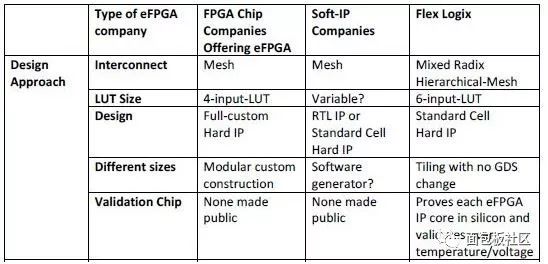Is there any difference between the embedded FPGA IP (eFPGA) products provided by these vendors? The difference is not big. How should engineers who do IC design choose? The author recently consulted the sales director of Flex Logix, he gave an answer, and provided a comparative form, which was elaborated.
According to Jane, the two main players in the market for eFPGA vendors are Achronix and Flex Logix. There is a very obvious difference between the two eFPGA products.

Table 1: Differences in design specifications between eFPGAs from different companies. (Source: Flex Logix)
First, Achronix itself provides FPGA hardware chips to customers, as well as Chiplets and eFPGA IP. Flex Logix is ​​a manufacturer specializing in embedded FPGA IP. From the perspective of business model, Flex Logix customers are very specific, only chip design companies, users are IC design engineers who understand FPGA. But Achronix users range from system designers using FPGAs to chip engineers using their eFPGA IP. Therefore, the product will be very different from the beginning.
 Table 2: In the back-end design, the practices of different eFPGA vendors are very different. (Source: Flex Logix)
Table 2: In the back-end design, the practices of different eFPGA vendors are very different. (Source: Flex Logix)
FPGA chip manufacturers on the market usually release a new generation of FPGA chips every three years, mainly based on the replacement cycle of the chip manufacturing process. "All the latest foundry processes, the earliest foundry customers, will definitely be FPGA chips. Because the complexity of FPGAs is much simpler than that of SoCs, manufacturing is much easier, and foundries can pull product yields at an early stage. Gao.†Jane told EE journalists the “hidden rules†of the chip manufacturing industry.
As FPGA customers need to use different DSP/RAM, different LUTs, DSP, and RAM modules are added to the FPGA chip. Even different ARM CPU cores have turned FPGA chips into heterogeneous SoCs.
Among these FPGA chip vendors, Achrnoix chose to provide both chip hardware and eFPGA. Companies such as Altera, Xilinx, and Lattice continue to remain in the FPGA chip market without providing eFPGA IP.

Flex Logix was recently announced as a member of the TSMC IP Alliance, the only member of TSMC's eFPGA IP. The TSMC processes already available include 40LP/ULP, 28HPM/HPC, 16FFC/FF+/12FFC and 7nm processes.
“Customers use our eFPGA IP to design, ranging from 100 LUTs to 200K LUTs, hundreds to thousands of user I/Os, support any type of RAM, and choose the DSP accelerator we offer.†Simply said, Flex Logix offers two small core EFLX 150 Logic\EFLX 150 DSPs with an Array range of 150 - 3.7K LUT4s, and two large core EFLX 4K Logic\EFLX 4K DSPs, ARRAY SIZES FROM 4K - 200K LUT4s.
Large core small cores can also be arranged in any combination, and chip design engineers can use flexible wiring and wiring in the chip.

Support for different metal stacks, which can bring great flexibility to the customer's chip design, without allowing customers to re-lay the metal layer, modify the GDS file, do more verification, and face potential design. risk.

Flex Logix's announced customers include SiFive, DARPA, Harvard, Sandia and others.
Finally, I explained to the EE Times, “As we get in touch with our customers, we are discovering more and more applications. In the IoT MCU, because this is a very segmented market, an MCU needs There are many different sensors connected, so the customer needs to reserve some programmable modules. The same is true for artificial intelligence and machine learning. In the field of memory controllers, the memory on the market is constantly introducing new standards and controls. How to meet the new storage standards, they need to add programmable modules to the chip. In the wireless field, because the 5G standard is not finalized, and the standards in each market are not the same, the programmable in the SoC Modules, both to increase the appropriate cost, while retaining the flexibility of the chip, also grabbed the earliest markets and customers."
With the emergence of emerging markets and the increasing cost of advanced chip manufacturing processes, it is a common practice to use FPGAs as prototypes in the design. At the same time, a new chip approach to the eFPGA IP module is added to the design. With the support of wafer foundries, it will continue to emerge in the future.
Dc Cross-Flow Fan,Dc Axial Fans,Dc Cross Flow Blower,Dc Cross Flow Fan
Original Electronics Technology (Suzhou) Co., Ltd. , https://www.original-te.com
